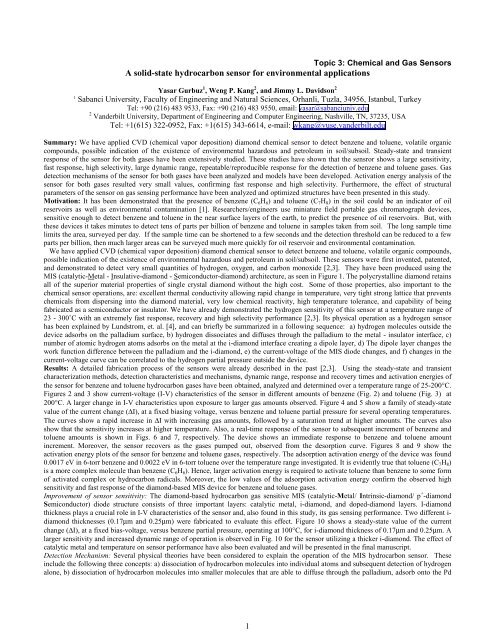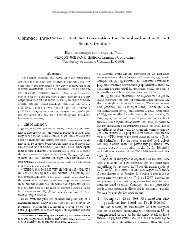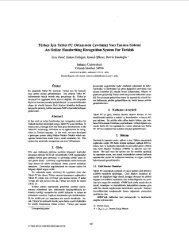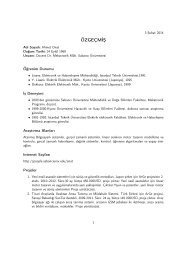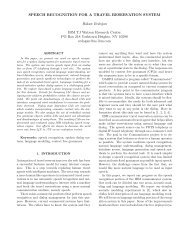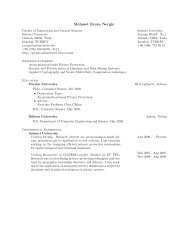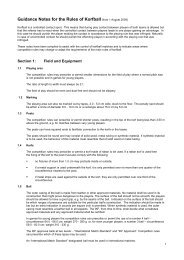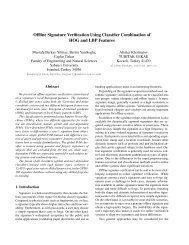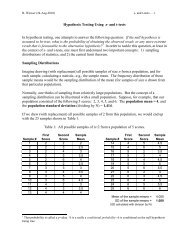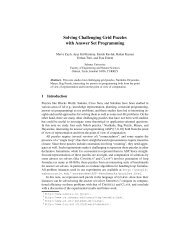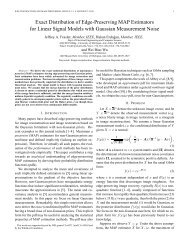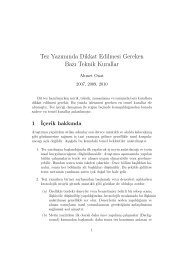Diamond Microelectronic Gas Sensor for Detection of Benzene and
Diamond Microelectronic Gas Sensor for Detection of Benzene and
Diamond Microelectronic Gas Sensor for Detection of Benzene and
Create successful ePaper yourself
Turn your PDF publications into a flip-book with our unique Google optimized e-Paper software.
Topic 3: Chemical <strong>and</strong> <strong>Gas</strong> <strong>Sensor</strong>s<br />
A solid-state hydrocarbon sensor <strong>for</strong> environmental applications<br />
Yasar Gurbuz 1 , Weng P. Kang 2 , <strong>and</strong> Jimmy L. Davidson 2<br />
1<br />
Sabanci University, Faculty <strong>of</strong> Engineering <strong>and</strong> Natural Sciences, Orhanli, Tuzla, 34956, Istanbul, Turkey<br />
Tel: +90 (216) 483 9533, Fax: +90 (216) 483 9550, email: yasar@sabanciuniv.edu<br />
2 V<strong>and</strong>erbilt University, Department <strong>of</strong> Engineering <strong>and</strong> Computer Engineering, Nashville, TN, 37235, USA<br />
Tel: +1(615) 322-0952, Fax: +1(615) 343-6614, e-mail: wkang@vuse.v<strong>and</strong>erbilt.edu<br />
Summary: We have applied CVD (chemical vapor deposition) diamond chemical sensor to detect benzene <strong>and</strong> toluene, volatile organic<br />
compounds, possible indication <strong>of</strong> the existence <strong>of</strong> environmental hazardous <strong>and</strong> petroleum in soil/subsoil. Steady-state <strong>and</strong> transient<br />
response <strong>of</strong> the sensor <strong>for</strong> both gases have been extensively studied. These studies have shown that the sensror shows a large sensitivity,<br />
fast response, high selectivity, large dynamic range, repeatable/reproducible response <strong>for</strong> the detection <strong>of</strong> benzene <strong>and</strong> toluene gases. <strong>Gas</strong><br />
detection mechanisms <strong>of</strong> the sensor <strong>for</strong> both gases have been analyzed <strong>and</strong> models have been developed. Activation energy analysis <strong>of</strong> the<br />
sensor <strong>for</strong> both gases resulted very small values, confirming fast response <strong>and</strong> high selectivity. Furthermore, the effect <strong>of</strong> structural<br />
parameters <strong>of</strong> the sensor on gas sensing per<strong>for</strong>mance have been analyzed <strong>and</strong> optimized structures have been presented in this study.<br />
Motivation: It has been demonstrated that the presence <strong>of</strong> benzene (C 6 H 6 ) <strong>and</strong> toluene (C 7 H 8 ) in the soil could be an indicator <strong>of</strong> oil<br />
reservoirs as well as environmental contamination [1]. Researchers/engineers use miniature field portable gas chromatograph devices,<br />
sensitive enough to detect benzene <strong>and</strong> toluene in the near surface layers <strong>of</strong> the earth, to predict the presence <strong>of</strong> oil reservoirs. But, with<br />
these devices it takes minutes to detect tens <strong>of</strong> parts per billion <strong>of</strong> benzene <strong>and</strong> toluene in samples taken from soil. The long sample time<br />
limits the area, surveyed per day. If the sample time can be shortened to a few seconds <strong>and</strong> the detection threshold can be reduced to a few<br />
parts per billion, then much larger areas can be surveyed much more quickly <strong>for</strong> oil reservoir <strong>and</strong> environmental contamination.<br />
We have applied CVD (chemical vapor deposition) diamond chemical sensor to detect benzene <strong>and</strong> toluene, volatile organic compounds,<br />
possible indication <strong>of</strong> the existence <strong>of</strong> environmental hazardous <strong>and</strong> petroleum in soil/subsoil. These sensors were first invented, patented,<br />
<strong>and</strong> demonstrated to detect very small quantities <strong>of</strong> hydrogen, oxygen, <strong>and</strong> carbon monoxide [2,3]. They have been produced using the<br />
MIS (catalytic-Metal - Insulative-diamond - Semiconductor-diamond) architecture, as seen in Figure 1. The polycrystalline diamond retains<br />
all <strong>of</strong> the superior material properties <strong>of</strong> single crystal diamond without the high cost. Some <strong>of</strong> those properties, also important to the<br />
chemical sensor operations, are: excellent thermal conductivity allowing rapid change in temperature, very tight strong lattice that prevents<br />
chemicals from dispersing into the diamond material, very low chemical reactivity, high temperature tolerance, <strong>and</strong> capability <strong>of</strong> being<br />
fabricated as a semiconductor or insulator. We have already demonstrated the hydrogen sensitivity <strong>of</strong> this sensor at a temperature range <strong>of</strong><br />
23 - 300˚C with an extremely fast response, recovery <strong>and</strong> high selectivity per<strong>for</strong>mance [2,3]. Its physical operation as a hydrogen sensor<br />
has been explained by Lundstrom, et. al. [4], <strong>and</strong> can briefly be summarized in a following sequence: a) hydrogen molecules outside the<br />
device adsorbs on the palladium surface, b) hydrogen dissociates <strong>and</strong> diffuses through the palladium to the metal - insulator interface, c)<br />
number <strong>of</strong> atomic hydrogen atoms adsorbs on the metal at the i-diamond interface creating a dipole layer, d) The dipole layer changes the<br />
work function difference between the palladium <strong>and</strong> the i-diamond, e) the current-voltage <strong>of</strong> the MIS diode changes, <strong>and</strong> f) changes in the<br />
current-voltage curve can be correlated to the hydrogen partial pressure outside the device.<br />
Results: A detailed fabrication process <strong>of</strong> the sensors were already described in the past [2,3]. Using the steady-state <strong>and</strong> transient<br />
characterization methods, detection characteristics <strong>and</strong> mechanisms, dynamic range, response <strong>and</strong> recovery times <strong>and</strong> activation energies <strong>of</strong><br />
the sensor <strong>for</strong> benzene <strong>and</strong> toluene hydrocarbon gases have been obtained, analyzed <strong>and</strong> determined over a temperature range <strong>of</strong> 25-200°C.<br />
Figures 2 <strong>and</strong> 3 show current-voltage (I-V) characteristics <strong>of</strong> the sensor in different amounts <strong>of</strong> benzene (Fig. 2) <strong>and</strong> toluene (Fig. 3) at<br />
200°C. A larger change in I-V characteristics upon exposure to larger gas amounts observed. Figure 4 <strong>and</strong> 5 show a family <strong>of</strong> steady-state<br />
value <strong>of</strong> the current change (∆I), at a fixed biasing voltage, versus benzene <strong>and</strong> toluene partial pressure <strong>for</strong> several operating temperatures.<br />
The curves show a rapid increase in ∆I with increasing gas amounts, followed by a saturation trend at higher amounts. The curves also<br />
show that the sensitivity increases at higher temperature. Also, a real-time response <strong>of</strong> the sensor to subsequent increment <strong>of</strong> benzene <strong>and</strong><br />
toluene amounts is shown in Figs. 6 <strong>and</strong> 7, respectively. The device shows an immediate response to benzene <strong>and</strong> toluene amount<br />
increment. Moreover, the sensor recovers as the gases pumped out, observed from the desorption curve. Figures 8 <strong>and</strong> 9 show the<br />
activation energy plots <strong>of</strong> the sensor <strong>for</strong> benzene <strong>and</strong> toluene gases, respectively. The adsorption activation energy <strong>of</strong> the device was found<br />
0.0017 eV in 6-torr benzene <strong>and</strong> 0.0022 eV in 6-torr toluene over the temperature range investigated. It is evidently true that toluene (C 7 H 8 )<br />
is a more complex molecule than benzene (C 6 H 6 ). Hence, larger activation energy is required to activate toluene than benzene to some <strong>for</strong>m<br />
<strong>of</strong> activated complex or hydrocarbon radicals. Moreover, the low values <strong>of</strong> the adsorption activation energy confirm the observed high<br />
sensitivity <strong>and</strong> fast response <strong>of</strong> the diamond-based MIS device <strong>for</strong> benzene <strong>and</strong> toluene gases.<br />
Improvement <strong>of</strong> sensor sensitivity: The diamond-based hydrocarbon gas sensitive MIS (catalytic-Metal/ Intrinsic-diamond/ p + -diamond<br />
Semiconductor) diode structure consists <strong>of</strong> three important layers: catalytic metal, i-diamond, <strong>and</strong> doped-diamond layers. I-diamond<br />
thickness plays a crucial role in I-V characteristics <strong>of</strong> the sensor <strong>and</strong>, also found in this study, its gas sensing per<strong>for</strong>mance. Two different i-<br />
diamond thicknesses (0.17µm <strong>and</strong> 0.25µm) were fabricated to evaluate this effect. Figure 10 shows a steady-state value <strong>of</strong> the current<br />
change (∆I), at a fixed bias-voltage, versus benzene partial pressure, operating at 100°C, <strong>for</strong> i-diamond thickness <strong>of</strong> 0.17µm <strong>and</strong> 0.25µm. A<br />
larger sensitivity <strong>and</strong> increased dynamic range <strong>of</strong> operation is observed in Fig. 10 <strong>for</strong> the sensor utilizing a thicker i-diamond. The effect <strong>of</strong><br />
catalytic metal <strong>and</strong> temperature on sensor per<strong>for</strong>mance have also been evaluated <strong>and</strong> will be presented in the final manuscript.<br />
<strong>Detection</strong> Mechanism: Several physical theories have been considered to explain the operation <strong>of</strong> the MIS hydrocarbon sensor. These<br />
include the following three concepts: a) dissociation <strong>of</strong> hydrocarbon molecules into individual atoms <strong>and</strong> subsequent detection <strong>of</strong> hydrogen<br />
alone, b) dissociation <strong>of</strong> hydrocarbon molecules into smaller molecules that are able to diffuse through the palladium, adsorb onto the Pd<br />
1
surface at the i-diamond interface causing a change in the work function <strong>and</strong> a subsequent change in the I-V relation, <strong>and</strong> c) movement <strong>of</strong><br />
the entire benzene or toluene molecule through the palladium to the i-diamond interface where it produces changes in the polarization <strong>of</strong><br />
the palladium surface. Each <strong>of</strong> these theories have been analyzed <strong>and</strong> results will be presented in the final manuscript.<br />
References<br />
[1] J. Getino, L. Ares, et. al., Environmental applications <strong>of</strong> gas sensor arrays:combustion atmospheres <strong>and</strong> contaminated soils, <strong>Sensor</strong>s<br />
<strong>and</strong> Actuators B 59 (1999) pp. 249-254<br />
[2] W. P. Kang, Y. Gurbuz, J. L. Davidson, <strong>and</strong> D. V. Kerns, New Hydrogen <strong>Sensor</strong> Using a Polycrystalline <strong>Diamond</strong>-Based Schottky<br />
Diodes, Journal <strong>of</strong> the Electrochem. Society, Vol. 141, No. 8, pp. 2231-2234, August 1994<br />
[3] W. P. Kang et al. 1997, US Patent No: 5,656,827<br />
[4] Lundstrom, K.I., M. S. Shivaraman <strong>and</strong> C. M. Svensson, “A Hydrogen-Sensitive Pd-Gate MOS Transistor,” J. Appl. Phys., Vol. 46, No.<br />
9, (Sept. 1975) pp. 3876-3881<br />
Figure 1: <strong>Diamond</strong>-based chemical sensor<br />
Figure 2<br />
Figure 3<br />
Figure 4<br />
Figure 5 Figure 6 Figure 7<br />
Ln(dI/dt)<br />
0.016<br />
0.014<br />
0.012<br />
0.01<br />
0.008<br />
0.006<br />
0.004<br />
0.002<br />
Ln(dI/dt) vs 1/T <strong>for</strong> <strong>Benzene</strong><br />
Ea=0.0017eV<br />
Ln(dI/dt)<br />
0.021<br />
0.016<br />
0.011<br />
0.006<br />
0.001<br />
Ln(dI/dt) vs 1/T <strong>for</strong> Toluene<br />
Ea=0.0022eV<br />
Effect <strong>of</strong> i-diamond thickness on <strong>Benzene</strong><br />
sensitivity<br />
0<br />
0.0024 0.0026 0.0028 0.003 0.0032 0<br />
0.0024 0.0026 0.0028 0.003 0.0032 -0.004<br />
0 2 4 6 8 10 12<br />
1/T<br />
1/T<br />
C 6H 6 Concentration(torr)<br />
Figure 8 Figure 9 Figure 10<br />
∆ I (mA)<br />
4.5<br />
4<br />
3.5<br />
3<br />
2.5<br />
2<br />
1.5<br />
1<br />
0.5<br />
i-diamond(0.25um)<br />
i-diamond(0.17um)<br />
2


